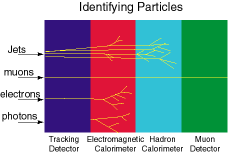 | In calorimeters different particles travel
different distances before being absorbed.
Photons and electrons lose energy very quickly and stop in the first layers of a calorimeter.
Muons, by contrast, can pass through many feet of steel before losing their energy.
Jets from quarks have an intermediate range. Physicists use the distance a particle
travels in a calorimeter to identify the particle.
|